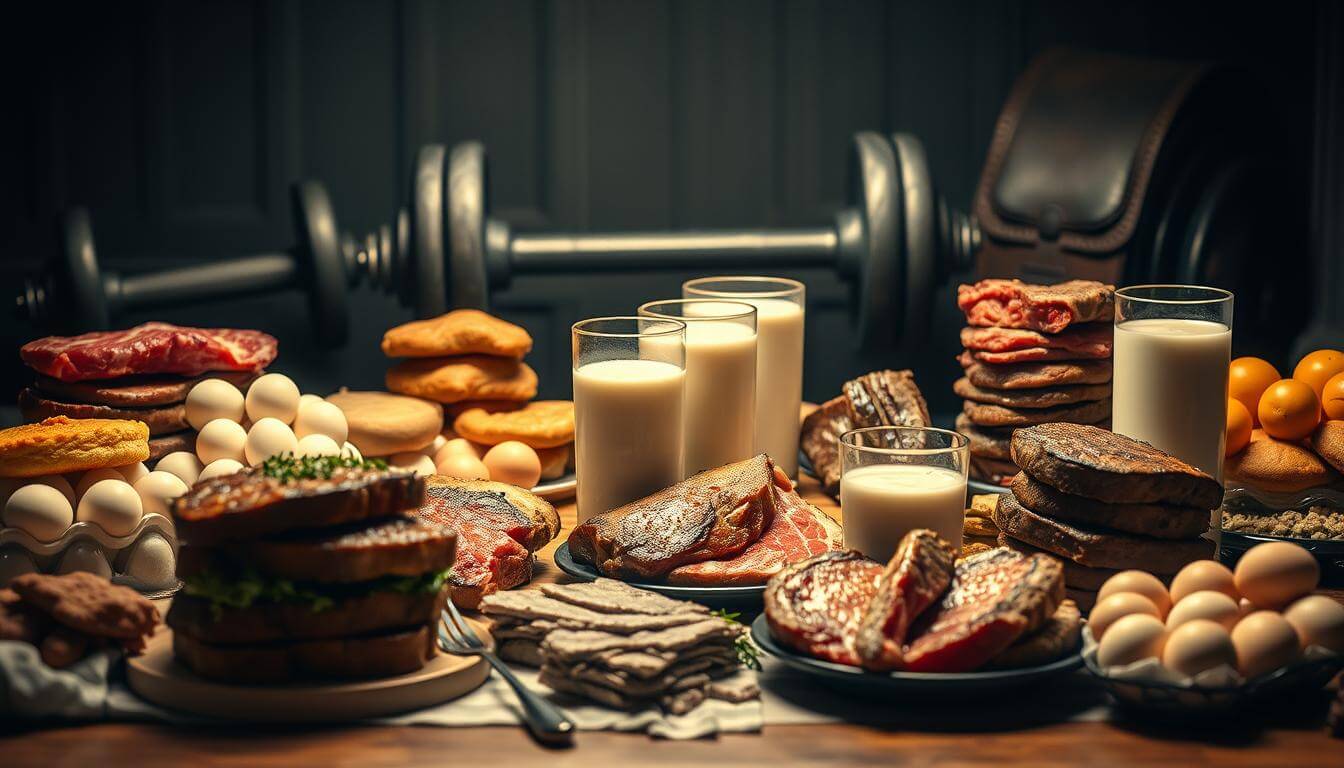What if the secret to building a strong, lean body lies in the way legends like Arnold Schwarzenegger and Bill Pearl fueled their workouts decades ago?
Back in the golden era of fitness, these icons relied on real, whole foods to achieve their incredible results.

Unlike today’s reliance on shakes and powders, they turned to natural sources like beef, eggs, and cottage cheese for their protein needs.
Carbohydrates from whole grains and vegetables fueled their intense training sessions, while meal timing played a crucial role in their success.
This article dives into the timeless strategies that helped these legends sculpt their physiques. Discover how simple, effective dietary habits from the past can still inspire your fitness journey today.
Introduction to the Golden Era of Bodybuilding Nutrition
During the golden era, nutrition was the cornerstone of legendary physiques. The 1970s and 1980s were a time when fitness icons relied on natural, whole foods to fuel their training and achieve incredible results.
Unlike today’s reliance on engineered supplements, these athletes turned to real, nutrient-dense sources like beef, eggs, and cottage cheese to meet their protein needs.
The Legacy of Timeless Diet Strategies
The golden era left a lasting legacy in the world of fitness. Athletes prioritized whole foods over powders and shakes, focusing on meals that supported their workout routines.
High-protein staples like chicken, fish, and dairy were essential, while carbohydrates from whole grains and vegetables provided sustained energy.
This approach wasn’t just about building muscle—it was about maintaining overall health. By avoiding processed products, bodybuilders of the time achieved a balance between strength and wellness.
How Nutrition Shaped the Legends
Nutrition played a pivotal role in sculpting the iconic physiques of the golden era. Athletes followed strict meal plans that aligned with their training programs. For example, a typical day might include:
- Breakfast: Eggs, oatmeal, and a glass of milk.
- Lunch: Grilled chicken with steamed vegetables.
- Dinner: Beef steak with a side of cottage cheese.
These meals were designed to maximize muscle growth and recovery. The focus was on quality, not quantity, ensuring every calorie served a purpose.
“Nutrition was the foundation of everything we did,” said one legendary bodybuilder. This mindset helped them achieve results that still inspire fitness enthusiasts today.
Understanding Old School Bodybuilding Diets: The Golden Era Method
The golden era of fitness was defined by simplicity and discipline in both training and nutrition.
Classic bodybuilders achieved legendary results by focusing on natural, whole foods. Their approach was straightforward yet effective, emphasizing quality over quantity.
Lifestyle and Food Choices of Classic Bodybuilders
Discipline was the cornerstone of their success. Every meal was planned to support their rigorous workout routines.
They relied on real, nutrient-dense foods like beef, eggs, and cottage cheese to meet their protein needs. These staples provided the building blocks for muscle growth and recovery.
Meal timing played a crucial role. They ate 4-6 times a day, ensuring a steady supply of energy and nutrients.
This consistency helped them maintain peak performance and achieve their goals. Unlike today’s reliance on shakes and powders, they preferred whole foods for their natural content.
Carbohydrates were carefully selected to fuel their intense training sessions. Whole grains, vegetables, and fruits provided sustained energy without the crash of processed carbs. This balance of protein and carbs was key to their success.
“It wasn’t just about eating—it was about eating with purpose,” said one legendary bodybuilder. This mindset helped them achieve results that still inspire fitness enthusiasts today.
Key Protein Strategies for Building Legendary Muscle
Protein has always been the cornerstone of muscle growth, but how legends like Bill Pearl achieved it is fascinating.
Unlike today’s reliance on shakes and powders, they turned to real, whole foods to fuel their physiques. This approach not only built muscle but also supported overall health.
Real Foods Versus Modern Protein Shakes
Modern protein supplements are convenient, but they lack the nutritional richness of whole foods.
Classic athletes like Bill Pearl relied on steak, eggs, and milk to meet their high protein needs. These foods provided not just protein but also essential vitamins and minerals.
For example, a 100-gram serving of cooked chicken breast offers about 32 grams of protein. Similarly, eggs and cottage cheese are packed with nutrients that support muscle repair and growth. “Real foods were our foundation,” Pearl once said, emphasizing their importance in his diet.
High-Protein Staples from the Golden Era
Golden era athletes prioritized natural sources like beef, chicken, and dairy. Bill Pearl famously followed the GOMAD (Gallon of Milk a Day) approach, consuming a gallon of milk daily to meet his protein and calorie needs.
This method ensured a steady supply of nutrients for muscle recovery.
Other staples included eggs, which provide about 8 grams of protein each, and cottage cheese, a slow-digesting protein source.
These foods were carefully timed to support intense training sessions and maximize results.
By focusing on whole foods, these athletes achieved a balance of strength and wellness that still inspires fitness enthusiasts today.
Balanced Carbohydrate Techniques for Energy and Recovery
Carbohydrates were the unsung heroes behind the legendary physiques of the golden era. They provided the energy needed for intense training sessions and played a crucial role in recovery.
By focusing on natural, unprocessed sources, bodybuilders maximized their results without relying on modern supplements.
Carb Cycling and Timing Around Workouts

Carb cycling was a popular strategy among classic bodybuilders. This involved adjusting carbohydrate intake based on training demands.
On heavy workout days, they consumed more carbs to fuel their sessions. On rest days, they reduced intake to avoid excess calorie storage.
Timing was also critical. Eating a meal rich in carbs 2 hours before exercise ensured optimal energy levels.
Post-workout, they focused on replenishing glycogen stores with foods like brown rice and whole-grain pasta. This approach supported both performance and recovery.
Natural Sources of Carbs for Sustained Energy
Golden era athletes relied on unprocessed, nutrient-dense foods for their carbohydrate needs.
Staples like potatoes, rice, and oatmeal provided sustained energy without the crash of refined carbs. These foods also offered essential vitamins and fiber, supporting overall fitness.
For example, a typical meal might include a baked potato with grilled chicken. This combination delivered both protein and carbs, making it ideal for muscle repair and energy replenishment.
“Natural carbs were the backbone of my diet,” said one legendary bodybuilder. This mindset helped them achieve results that still inspire athletes today.
Embracing Fats: Fueling Muscle Growth the Old School Way
Fats were a cornerstone of muscle-building strategies in the golden era, offering more than just energy.
They played a vital role in hormone production and overall fitness. Unlike modern low-fat trends, classic athletes embraced fats from natural sources like beef, dairy, and whole eggs to fuel their physiques.
Understanding Dietary Fats and Anabolic Hormones
Dietary fats are essential for the production of anabolic hormones like testosterone and growth hormone.
These hormones are critical for muscle growth and recovery. Classic bodybuilders understood this and incorporated high-fat foods into their diet to optimize hormone levels.
For example, whole eggs are rich in healthy fats and cholesterol, which support testosterone synthesis.
Similarly, red meat and dairy provide saturated fats that are crucial for hormone health. “Fats were never the enemy,” said one legendary bodybuilder. “They were the fuel that powered our progress.”
The Role of Fat in Classic Diets
In the golden era, fats were not just consumed—they were strategically used. During bulking phases, athletes increased their fat intake to support calorie surplus and muscle growth. In cutting phases, they adjusted fat levels to maintain energy without excess storage.
Foods like cream, butter, and whole eggs were staples. These provided not only fats but also essential nutrients. For instance, a single egg contains 15 grams of fat, making it a powerful source of energy and nutrition.
Today, incorporating healthy fats into your diet can yield similar results. Focus on natural sources like avocados, nuts, and fatty fish. Balance is key—ensure fats complement your overall nutrient intake without compromising your calorie goals.
By embracing fats, you can fuel your training and achieve a strong, muscular physique, just like the legends of the past.
Pioneering Supplements: Then and Now
The supplement industry has come a long way since its humble beginnings in the golden era of fitness.
Back then, athletes relied on real, whole foods to fuel their fitness journeys. Supplements were minimal, with products like brewer’s yeast and desiccated liver being the go-to options.
Today, the market is flooded with advanced formulas, from pre-workout blends to testosterone boosters.

A Minimalist Approach to Nutritional Aids
Classic bodybuilders believed in the philosophy of “food first.” They prioritized nutrient-dense meals over powders and pills.
Staples like beef, eggs, and dairy provided the protein and fat needed for muscle growth.
Supplements were used sparingly, often during off-training periods to fill gaps in their diet.
“We didn’t need fancy products—we had real food,” said one legendary bodybuilder. This mindset ensured they achieved results without relying on modern conveniences.
The Evolution from Food-Based Nutrition to Modern Supplements
In the 1950s, the idea of using supplements for fitness was still in its infancy. Early products like brewer’s yeast and desiccated liver were simple but effective. By the 1970s, protein powders began to gain popularity, though they were far from the advanced formulas we see today.
Fast forward to the 21st century, and the supplement industry is worth over $150 billion.
Modern products offer convenience, but the foundation of nutrition remains rooted in real foods.
For example, a balanced diet with eggs, lean meats, and whole grains can provide the same nutrients as many supplements.
While modern aids can enhance performance, the minimalist approach of the past teaches us to prioritize whole foods. “Supplements are tools, not replacements,” says a seasoned bodybuilder. This balance ensures long-term success in any fitness journey.
Sample Meal Plan: A Day in the Life of a Golden Era Bodybuilder
Fueling a legendary physique required more than just lifting weights—it demanded a disciplined approach to nutrition.
Classic athletes followed structured meal plans designed to maximize muscle gain and recovery.
Let’s break down a typical day for a bodybuilder from the past, focusing on meal timing, portion sizes, and strategic cheat days.
Meal Timing and Structure for Muscle Gain
Consistency was key. Athletes ate 4-6 meals a day, ensuring a steady supply of nutrients. Here’s a sample plan:
- Breakfast: 3-4 whole eggs, a serving of oatmeal, and a glass of milk. This meal provided a mix of protein and complex carbs to kickstart the day.
- Mid-Morning Snack: Tuna or hard-boiled eggs for a quick protein boost.
- Lunch: Grilled chicken breast, steamed vegetables, and a side of brown rice. This balanced meal supported recovery and energy levels.
- Afternoon Snack: Cottage cheese with a handful of nuts. The slow-digesting protein kept muscles fueled.
- Dinner: Beef steak, sweet potatoes, and a green salad. This meal provided essential nutrients for overnight recovery.
- Evening Snack: A glass of milk or a small serving of Greek yogurt to ensure sustained protein intake.
Each meal was timed to align with training sessions, ensuring optimal performance and recovery.
Incorporating Cheat Days Without Compromise
Even the most disciplined bodybuilders allowed themselves a weekly cheat day. This wasn’t about overindulgence but about mental and physical balance.
A cheat meal might include a favorite dish like pizza or ice cream, but it was carefully planned to avoid derailing progress.
“Cheat days kept me sane,” said one classic athlete. “They reminded me that fitness is a lifestyle, not a punishment.” By sticking to their diet 90% of the time, they could enjoy occasional treats without guilt.
To adapt this plan to your routine, focus on portion control and balance. Adjust meal sizes based on your calorie needs and training intensity. Remember, consistency and quality are the foundation of success.
Conclusion
The timeless principles of classic fitness nutrition still hold immense value today. Legends like Arnold Schwarzenegger and Bill Pearl achieved incredible results by focusing on high-quality protein, balanced carbohydrates, and healthy fats.
Their disciplined approach to meal planning and reliance on natural food sources set the standard for success.
While modern supplements offer convenience, the foundational strategies of the past remain highly effective.
Experimenting with these time-tested methods can help you achieve your fitness goals. Tailor your diet to your individual needs, emphasizing simplicity and consistency.
Reflect on your current habits and consider integrating aspects of these classic strategies into your routine. By prioritizing natural, whole foods and maintaining discipline, you can build a strong, lean physique—just like the bodybuilders of the past.
FAQ
What were the key food choices in the Golden Era of bodybuilding?
Classic bodybuilders relied on whole, nutrient-dense foods like eggs, beef, chicken, fish, cottage cheese, and milk. These provided high-quality protein, healthy fats, and essential nutrients for muscle growth and recovery.
How did bodybuilders in the Golden Era approach protein intake?
They prioritized real food sources like steak, eggs, and cottage cheese over modern protein shakes. These foods were rich in complete proteins and supported muscle repair and growth effectively.
What role did carbohydrates play in classic bodybuilding diets?
Carbs were used strategically for energy and recovery. Bodybuilders focused on natural sources like oats, rice, and vegetables, often timing their intake around workouts for optimal performance.
Were fats included in Golden Era bodybuilding diets?
Yes, healthy fats were essential. Foods like eggs, whole milk, and beef provided dietary fats that supported hormone production and overall health, contributing to muscle growth.
Did Golden Era bodybuilders use supplements?
Supplements were minimal and often food-based, like desiccated liver tablets. The focus was on whole foods, with modern supplements like whey protein and pre-workouts being introduced later.
How did meal timing work in classic bodybuilding diets?
Meals were spaced evenly throughout the day, with an emphasis on protein-rich foods. Pre- and post-workout meals were carefully planned to maximize energy and recovery.
Were cheat meals part of Golden Era bodybuilding diets?
Yes, occasional cheat meals were allowed to satisfy cravings and boost mental motivation. However, they were balanced with disciplined eating to maintain progress.
What can modern fitness enthusiasts learn from Golden Era nutrition?
The focus on whole, unprocessed foods, balanced macronutrients, and disciplined meal timing remains a timeless approach for building muscle and improving health.
